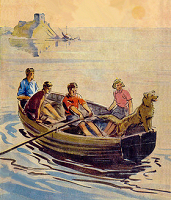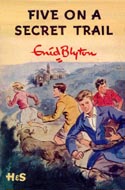
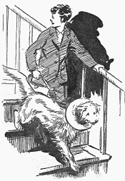
George sneaks off with Timmy and his silly collar.
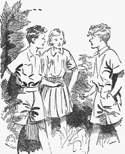
George and Anne meet the nice boy working on an old Roman dig nearby.

In the night, Anne sees light in the old, empty cottage.
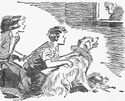
A nasty-looking man is prowling about!
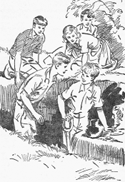
Together again, the Five are interested in the old dig.
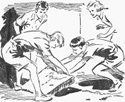
Who's been lifting this old stone, and why?
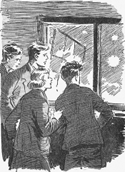
A ghostly display of lights and noises! How queer!
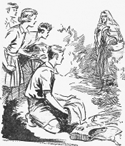
A "farm woman" comes to see if the Five are really leaving.

Hiding in the empty cottage, Julian and Dick see a procession of torchlights.
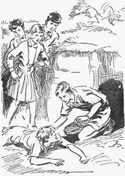
The Five find the boy crying for his kidnapped brother. What? Brother? Twin brother?
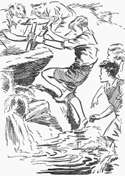
The entrance to the secret trail? What will they find?
Five On a Secret Trail
Review by Keith Robinson (August 29, 2005)
The fifteenth book in the series has a better title than the last, and on the whole has a fairly exciting premise: The Five are camping out on the common, near an old, empty cottage where strangers keep nosing around in the dead of night, looking under stone slabs of a certain size. Why all the secrecy? Why do the strangers put on a ghostly light show to scare the Five away?
For some reason, though, this book is very weak. The usual motley crew of bad guys, the usual secret tunnels, the usual valuable treasure (albeit not the usual jewels or cash or gold)... It all just whiffs of the same tired ideas regurgitated in another form.
It seems that the boys, Julian and Dick, are away in France for the holidays, so it's only Anne who is soon coming to stay at Kirrin with George. But before she arrives, Timmy cuts his ear rather badly. George's mother suggests Timmy goes to the vet, so off George goes with him—and Timmy's ear is stitched up. But, the vet warns, Timmy must not scratch his ear at all, or the stitches will come out and the wound will re-open. So Timmy is forced to wear a comical cardboard collar, which everyone laughs at—much to George's chagrin. She is so concerned for Timmy's feelings, and so annoyed at people for being so rude, that she takes off in the night to go camping on the common, away from laughing, jeering people. The collar itself is something I remember well; it's right up there with Clopper the pantomime horse (Five Go Down to the Sea) and "Two-Trees, Saucy Jane, and Maggie Knows" (Five on a Hike Together). And it does provide an original excuse for the Five to go camping.
George's mother, seeing the note left for her, is not overly concerned about her only daughter staying out on the common on her own (such is the innocence of Blyton's world). And George has left instructions for Anne when she arrives: "Tell Anne to come to the end of Carter's Lane on the common and I'll show her where I'm camping." So Anne, loaded up with extra supplies, sets off to the common and soon joins up with George, who has picked a place near a stream of cold, crystal clear water. An old cottage stands nearby, empty and falling apart, but George and Anne camp some distance from it, out in the open air.
One day they meet a strange boy. He doesn't give his name, but he's a cheerful sort of person and the girls take a liking to him at once—even if he is a bit of a clown. The boy is working on an archeological Roman dig nearby, and he would prefer it if the girls didn't come nosing about there. "Fine," the girls say, "if you don't come pestering us." (Or words to that effect.) So an agreement is reached. But, soon after, the boy comes waltzing along near to where they're camping and looks surprised when the girls tick him off for breaking a promise. He says he made no such promise and remembers nothing of their first encounter. Straight away I saw where this was going: here we have a set of twin brothers, one jolly and nice, the other a little grumpy, and neither one acknowledging the presence of the other and thus creating a sense of confusion for the girls. This happens a lot in TV comedies and stage plays, and is good for a belly laugh—and perhaps in real life it would be strange and confusing to meet first one twin and then the other, and get alternate reactions each time. But there are a few things that don't wash here. First there's the fact that the boy doesn't give his name. This is a case of the author avoiding the possibility of George saying, "Hi, Guy!" (as his name turns to be) to the wrong twin—which would sort of blow the whole gag. Second, are we to assume that the twins wear the exact same identical clothing at all times? Because even identical twins can occasionally wear something slightly different, and since the girls run across this pair frequently, sometimes within minutes of each other, a different set of clothes might have given them a clue.
But twins they are. Guy and Harry Lawdler. I'm just glad Blyton gave a semi-valid reason for the twins not letting on that there were in fact two of them—because they'd had a fight and were now pretending one another didn't exist. Still, it's a little weak; clearly each knew all along what the girls were confused about, and yet the twins insisted on pretending the girls were barmy.
On with the story. One night Anne goes to get a drink of water from the stream, and on the way back to the camp loses her way and ends up at the old cottage. And inside she sees lights and hear noises. But in the morning George convinces her she must have been dreaming, so the matter is forgotten. But when a storm passes through, the girls decide to take refuge in the cottage. So, with lightning flashing, it's a great shock when they see someone peering in through a window at them!
Frightened now, the girls decide to go home in the morning. But just as they are packing up their things, Julian and Dick arrive—back unexpectedly from France! (How they knew exactly where on the common to find George and Anne is a mystery, but a minor one not worth dwelling on.) Now the Five are together once more, and they can all stick around and have some fun!
But there really are some queer folk about, who seem to be interested in something buried under a stone slab in the old cottage—the Five can tell it's been lifted recently. That must have been what Anne heard that night, when she thought she was dreaming! When the boys lift the slab to see what's there, they find nothing but dirt. Maybe the strangers lifted the wrong slab then?
When the Five witness a strange and eerie light show one night, with curious whining sounds filling the air, they quickly come to the conclusion that someone is trying to scare them off. So next morning they pack and pretend to leave, with a plan of lying low and watching to see what happens. A "farm woman" arrives to ask if they're leaving, and Julian plays along and tells her that they are on their way home. Then night falls, and the fun starts! What will they find? Julian and Dick hide out in the cottage to see what happens if and when the strangers arrive...
They've only been there forty-five minutes when the strangers do in fact arrive. One of Blyton's little nuances is to make sure her children aren't hanging about for long before something happens. Whenever they get ready to spy on someone or something, they just set out at "about the right time" and snuggle down into hiding. Then the baddies will come along and reveal everything they know in a play of contrived conversation. Now we find out everything, including that the "farm woman" is one of the gang, and that they are all trying to find the entrance to a tunnel which leads to some kind of treasure left there by Paul, their sick colleague.
Of course the Five get there first. I could make a very silly nitpick about the underground tunnels they happen across and explore. Harry (or actually his twin Guy, who I would assume to be exactly like Harry in all respects) is said to be twelve or thirteen, short and sturdily built—so the same age as Julian but perhaps broader. In the tunnels there's a particularly narrow section that everyone can just about squeeze through except Julian. Well, maybe Julian's the tallest—this is described a lot throughout the series—but I never saw him as sturdily built. Yet it's Julian that gets stuck in the tunnel, while Harry isn't even mentioned. Well, as I said, I could make a very silly nitpick about this, but I won't for fear of being facetious. Oh wait—!
Another nitpick relates to the entrance to the tunnel. The strangers speak of a man called Paul, who apparently is ill but managed to draw a map with directions on how to find the "treasure." The directions speak of the entrance being on the common near the dig, under a stone slab (apparently of a specified size) and next to water. It turns out there are two entrances, one within the Roman dig—this hole reportedly ending at a roof fall—and the other next to a stream right where the Five are camping. It's pure coincidence that George happened to pick that very spot when she first set out to camp on the common, but when she sees the stone slabs on the banks of the stream she realizes this might be Paul's secret entrance! Stone slab—water—it must be right!
But if so, how come it takes so much work for the Five to move the heavy slab? It's "too heavy and well-embedded" so Harry has to run and get his tools to get the thing shifted, and even then it takes all their combined effort to wrestle it into the stream. Behind the slab is a hole that they have to widen, because "earth and roots have narrowed it very much"—and yet supposedly this Paul fellow must have been through that way not so long ago (and presumably alone) to place the treasure underground in the first place. He couldn't have come in the other way, through the dig, because that way is blocked by a roof fall. Something doesn't quite add up here, especially as it turns out the treasure hasn't even been noticed stolen yet—which means the robbery must have been fairly recent. So why does the stone appear to have been there a long time? And why go to so much trouble anyway—finding this secret passage, crawling about inside, marking arrows on the walls of the tunnels, replacing the stone and all the rest? I can think of a hundred easier, quicker hiding places for a desperate man wanting to stash stolen goods.
Eventually the Five and Harry find Guy, who has been dumped in the tunnels and left with a hurt ankle. As luck would have it, the Five (plus twins) have a bit of time to get away safely because the strangers have gone off to get some tools so they can dig their way through the roof fall, which they believe to be the only way through. This is where Blyton conveniently adds that Guy's and Harry's tools have all been hidden away—good job too, because otherwise they would have been back in a jiffy and the entire happy ending would have fallen through.
The final groan comes when Uncle Quentin, the mad scientist of Kirrin, instantly recognizes the "treasure" as a very valuable blueprint, one of only two copies in the world—one of which Quentin has in his possession. WHAT a coincidence! Since he still has his, it must be the other copy that has gone missing. And a quick telephone call later proves this to be the case—but no matter, because thanks to the Five, the blueprint has been recovered.
This is, for me, the weakest Famous Five story in the series so far. Even Five Have Plenty of Fun, which seemed to repeat a lot of ideas from earlier books, and had a pantomime door-banging scene at the end, was a much more interesting read despite those flaws. Somehow, even with its vaguely interesting title and exciting premise, Five on a Secret Trail is a poor read, and riddled with holes large enough to squeeze through.
Off to Billcock Hill next...


